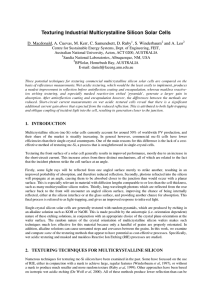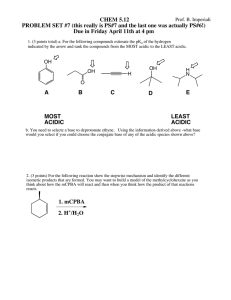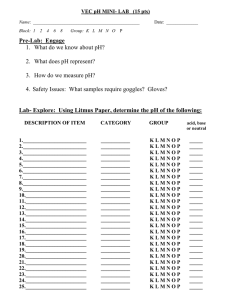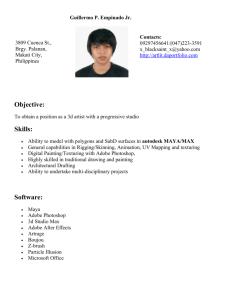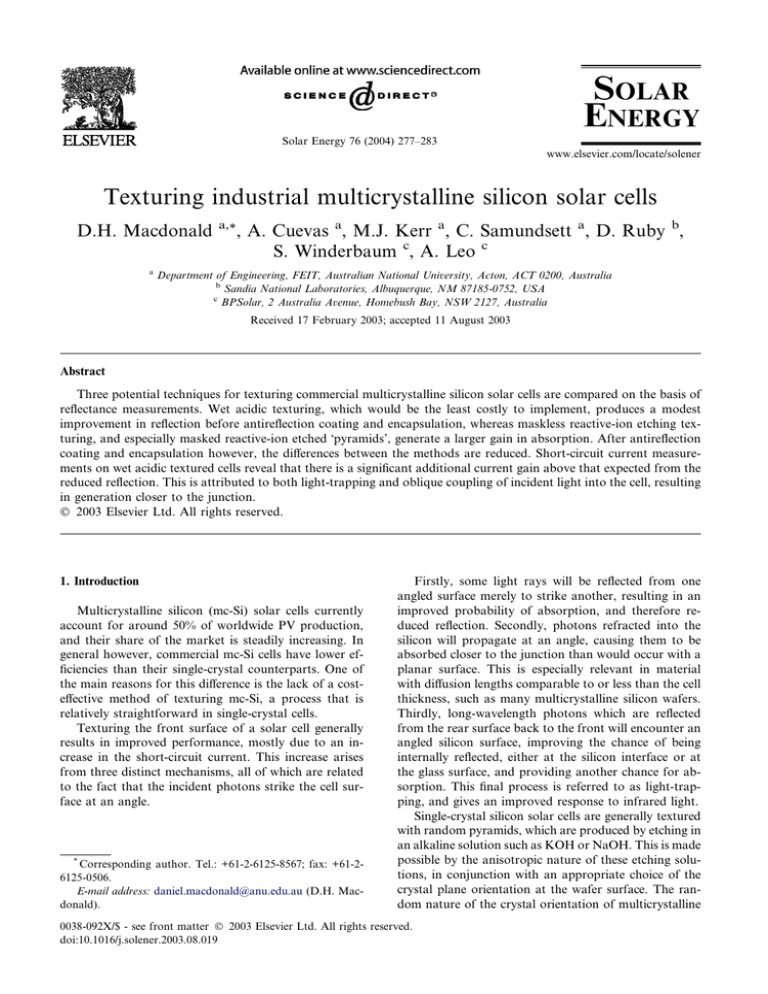
Solar Energy 76 (2004) 277–283
www.elsevier.com/locate/solener
Texturing industrial multicrystalline silicon solar cells
D.H. Macdonald
a
a,*
, A. Cuevas a, M.J. Kerr a, C. Samundsett a, D. Ruby b,
S. Winderbaum c, A. Leo c
Department of Engineering, FEIT, Australian National University, Acton, ACT 0200, Australia
b
Sandia National Laboratories, Albuquerque, NM 87185-0752, USA
c
BPSolar, 2 Australia Avenue, Homebush Bay, NSW 2127, Australia
Received 17 February 2003; accepted 11 August 2003
Abstract
Three potential techniques for texturing commercial multicrystalline silicon solar cells are compared on the basis of
reflectance measurements. Wet acidic texturing, which would be the least costly to implement, produces a modest
improvement in reflection before antireflection coating and encapsulation, whereas maskless reactive-ion etching texturing, and especially masked reactive-ion etched Ôpyramids’, generate a larger gain in absorption. After antireflection
coating and encapsulation however, the differences between the methods are reduced. Short-circuit current measurements on wet acidic textured cells reveal that there is a significant additional current gain above that expected from the
reduced reflection. This is attributed to both light-trapping and oblique coupling of incident light into the cell, resulting
in generation closer to the junction.
2003 Elsevier Ltd. All rights reserved.
1. Introduction
Multicrystalline silicon (mc-Si) solar cells currently
account for around 50% of worldwide PV production,
and their share of the market is steadily increasing. In
general however, commercial mc-Si cells have lower efficiencies than their single-crystal counterparts. One of
the main reasons for this difference is the lack of a costeffective method of texturing mc-Si, a process that is
relatively straightforward in single-crystal cells.
Texturing the front surface of a solar cell generally
results in improved performance, mostly due to an increase in the short-circuit current. This increase arises
from three distinct mechanisms, all of which are related
to the fact that the incident photons strike the cell surface at an angle.
*
Corresponding author. Tel.: +61-2-6125-8567; fax: +61-26125-0506.
E-mail address: daniel.macdonald@anu.edu.au (D.H. Macdonald).
Firstly, some light rays will be reflected from one
angled surface merely to strike another, resulting in an
improved probability of absorption, and therefore reduced reflection. Secondly, photons refracted into the
silicon will propagate at an angle, causing them to be
absorbed closer to the junction than would occur with a
planar surface. This is especially relevant in material
with diffusion lengths comparable to or less than the cell
thickness, such as many multicrystalline silicon wafers.
Thirdly, long-wavelength photons which are reflected
from the rear surface back to the front will encounter an
angled silicon surface, improving the chance of being
internally reflected, either at the silicon interface or at
the glass surface, and providing another chance for absorption. This final process is referred to as light-trapping, and gives an improved response to infrared light.
Single-crystal silicon solar cells are generally textured
with random pyramids, which are produced by etching in
an alkaline solution such as KOH or NaOH. This is made
possible by the anisotropic nature of these etching solutions, in conjunction with an appropriate choice of the
crystal plane orientation at the wafer surface. The random nature of the crystal orientation of multicrystalline
0038-092X/$ - see front matter 2003 Elsevier Ltd. All rights reserved.
doi:10.1016/j.solener.2003.08.019
278
D.H. Macdonald et al. / Solar Energy 76 (2004) 277–283
Nomenclature
short circuit current density (mA cm 2 )
JSC
RIE
reactive ion etching
PECVD plasma-enhanced chemical vapour deposition
silicon wafers makes such techniques much less effective
for this material because only a handful of grains are
properly orientated. In addition, alkaline solutions can
cause unwanted steps and crevasses between the grains.
In this work, we examine and compare some of the
texturing methods that appear to have potential as costeffective processes. Specifically, wet acidic texturing and
masked and maskless reactive ion etching (RIE) processes are studied.
2. Texturing techniques for multicrystalline silicon
Numerous techniques for texturing mc-Si silicon
have been examined in the past. Some have focussed on
the use of RIE, either in conjunction with a mask to
achieve large, regular features (Winderbaum et al.,
1997), or without a mask to produce much smaller and
more random texture (Ruby et al., 1999). Other approaches have been based on isotropic wet acidic etching (De Wolf et al., 2000). All of these methods produce
lower reflection than can be achieved with the standard alkaline damage-removal etch used today in industry.
Wet acidic texturing, performed with solutions containing HF/HNO3 that tend to etch isotropically, can
result in features with rounded surfaces, as opposed to
flat-sided features which arise from anisotropic etches
(De Wolf et al., 2000). These rounded features produce a
scalloped surface that can have good antireflection
properties. An important issue with this technique is that
the feature growth needs to be Ôseeded’ in some way,
otherwise a planar surface will result. This seeding can
be provided by surface damage caused during wafer
sawing (maskless acidic etching), or, in more complex
methods, by defined holes through protective layers such
as oxides, nitrides or polymers (masked acidic etching).
In this paper we examine and evaluate a maskless acidic
etching technique. Such a technique does not provide the
extremely low reflection of some other methods, but
does have the advantages of being relatively easy to
implement and low-cost.
Reactive ion etching (RIE) is a method for Ôdry’
etching silicon without the use of large quantities of
liquid solutions. It is based on placing wafers in a
plasma of highly reactive ions. Under certain conditions,
the etching dynamics produce deep surface features that
ARC
SEM
antireflection coating
scanning electron micrograph
have excellent antireflection properties. Like wet acidic
etching, RIE can be performed in a maskless fashion
that produces somewhat randomly placed features, or in
conjunction with a masking layer to produce more even
features. In this paper, we compare the wet acidic texturing with both a masked and a maskless RIE texturing
method. The maskless RIE texturing was performed at
Sandia laboratories in the USA using a proprietary
Ômetal-assisted’ process (Ruby et al., 1999). Masked RIE
texturing was created by etching through phtolithographically defined holes in a metal layer which is subsequently removed (Winderbaum et al., 1997). Both of
these techniques offer promise for very low reflectance
surfaces with minimal chemical waste, an issue that will
become increasingly important in the photovoltaic industry. However, they are likely to be more costly to
implement than wet chemical methods.
3. Results and discussion
To provide a baseline with which to compare the
three types of texture studied in this paper, we have
characterised wafers from BPSolar’s current industrial
alkaline-etching method for producing a damage-free,
but optically flat, surface. We have also studied as-cut
wafers, which remain in the damaged state after wafer
sawing. Because of the surface damage, they have relatively low reflection. However, the damage also produces many regions of high recombination, which
severely degrade cell performance. This highlights the
important point that generating good texture has to be
coupled with a relatively damage-free surface.
3.1. Electron micrographs of as-cut, etched and textured
wafers
Fig. 1 shows scanning electron micrographs (SEMs)
of multicrystalline silicon wafers with various surfaces.
In the as-cut wafer (top two images), the heavy surface
damage is evident as deep fissures and cracks, resulting
in reasonable reflection control but high recombination.
The next two images are of a standard industrial alkaline-etched wafer. It appears to have some texturing, but
this is both shallow and highly grain-dependent, and
when averaged over many grains is almost as reflective
as a perfectly flat wafer. This reflects the fact that the
D.H. Macdonald et al. / Solar Energy 76 (2004) 277–283
279
Fig. 1. SEM images of various mc-Si surfaces. From top to bottom: as-cut (left 1000·, right 5000·), alkaline-etched (both 500·,
different grains), acidic textured (left 500·, right 5000·), maskless RIE textured (left 1000·, right 5000·) and masked RIE pyramids
(2000·, from Winderbaum et al., 1997).
alkaline etching solution used by BPSolar is relatively
isotropic in comparison to solutions sometimes used for
texturing single-crystal wafers.
The following two images are of an acidic textured
wafer, which was performed with a HF/HNO3 solution.
A wetting agent was added to produce more uniform
texturing. Approximately 5–10 lm of silicon was removed from each surface. Although the surface damage
is removed, its original presence is nevertheless critical,
since it acts as a seeding layer for the texturing. The
280
D.H. Macdonald et al. / Solar Energy 76 (2004) 277–283
resulting surface contains smooth sided, bowl-like features.
Fig. 1 also shows images of the maskless RIE texturing performed at Sandia. These wafers have somewhat randomly placed but nevertheless deep features
with steep sides, which provide very low reflection. Note
that the features of these RIE textured wafers are much
smaller than those of the acidic textured sample (the two
images on the right have the same magnification, 5000·).
Finally, a masked RIE textured wafer is also shown at
the bottom of Fig. 1. These features are very regular and
steep-sided, with a distance of 7 lm between pyramid
peaks. The pyramids are approximately the same size as
the features on the wet acidic textured wafer.
3.2. Reflectance measurements
Fig. 2 shows the results of reflectance measurements
on the three types of textured wafers, plus alkalineetched and as-cut samples. These curves have been used
to calculate weighted reflectances for the AM1.5G
spectrum. The results are shown in Table 1.
As discussed above, the alkaline etch, which is optimised for removing the saw damage, not for texturing,
produces a high reflectance. In fact, for samples of this
thickness (about 275 lm), a perfectly polished surface
would also produce a reflectance of around 34%. The ascut surface exhibits reasonable reflection control, but, as
100
Reflectance (%)
90
alkaline-etched
Bare wafers
80
acidic textured
70
as-cut
60
maskless RIE
50
masked RIE pyramids
40
30
20
10
0
300
400
500
600
700
800
900
1000
1100
1200
Wavelength (nm)
Fig. 2. Reflectance measurements of bare alkaline-etched, ascut, acidic textured, masked RIE and maskless RIE textured
multicrystalline silicon wafers.
shown below, is electronically unacceptable for cell
production.
The acidic textured sample produced a weighted reflectance somewhat lower than the alkaline etch, but
certainly not as good as the RIE textured samples.
However, this may be offset by the relative ease of implementing acidic texturing. Purely in terms of reflectance though, the results for the RIE texturing processes
are very good. It should be noted that the reflectance of
acidic textured wafers could be improved with further
optimisation, as shown by De Wolf et al. (2000), who
have achieved weighted reflectances on bare wafers
of about 22% (as opposed to 27.6% here).
While the results of the bare wafers give a good indication of the effectiveness of the various texturing
methods, in a real cell the surface will have an encapsulated antireflection coating (ARC), which will further
change the overall reflection properties. Therefore, we
have measured the reflectance of the textured surfaces
coated with a plasma-enhanced chemical vapour deposited (PECVD) SiN film, both before and after encapsulation. A major advantage of PECVD SiN films is
that they also electronically passivate the surface, leading to reduced recombination losses. Hence there are
two separate issues to consider here: firstly, the optical
properties of the SiN coated textured surfaces, and
secondly, how well the SiN film passivates the textured
surfaces. The quality of the surface passivation is revealed by lifetime measurements, which are presented in
the next section. Firstly though, we present reflectance
results on SiN coated wafers.
The results before encapsulation are shown in Fig. 3.
As expected, all have dramatically reduced reflectance in
comparison to the bare wafers, as also indicated by the
weighted reflectances in Table 1.
The results for the unencapsulated wafers show that
the difference between the various textures and the alkaline etched surface has been reduced. Initially, this
appears to diminish the relative benefit of the texturing
processes. However, this does not accurately represent
the real case of a finished solar cell inside a module.
When encapsulated under glass, and with a rear reflector
in place, the samples with more textured surfaces will
have relatively improved reflectances due to light-trapping. This is indicated in the third row of Table 1. These
encapsulated measurements were taken with a 90% re-
Table 1
Weighted AM1.5 reflectivities of bare, SiN-coated and SiN-coated/encapsulated wafers with various surfaces
Bare
With SiN AR coating
SiN & encapsulated
As-cut
Alkaline etched
Acidic textured
Maskless RIE
Masked RIE pyramids
22.6%
7.6
8.9
34.4
9.0
12.9
27.6
8.0
9.2
11.0
3.9
7.6
5.6*
n/a
n/a
Data marked * from Winderbaum et al. (1997).
D.H. Macdonald et al. / Solar Energy 76 (2004) 277–283
sulation. In comparison to the alkaline-etched wafer, the
acidic wafer gives a 3.7% reduction in reflectance, while
the maskless RIE wafer yields a gain of 5.3%. It may be
that the extra cost of RIE processes is warranted by this
extra gain.
100
alkaline-etched
acidic textured
as-cut
maskless RIE
90
Reflectance (%)
80
70
SiN coated wafers
unencapsulated
60
281
50
40
30
3.3. Lifetime measurements
20
10
0
300
400
500
600
700
800
900
1000
1100
1200
Wavelength (nm)
Fig. 3. Reflectance measurements of SiN coated, but unencapsulated, multicrystalline silicon wafers.
flective mirror behind the wafer. This reasonably closely
simulates the case in a finished cell which has a rear
reflectivity of about 70% due to the Al back surface field.
A more direct illustration of the light-trapping effect
is given by the infrared region of the reflectance curves
of Fig. 4. At wavelengths greater than 1000 nm, the
benefits of light-trapping in the textured wafers as opposed to the alkaline-etched sample is clear. The RIE
textured wafer in particular exhibits good light-trapping.
The reflectivity curves shown in the previous figures
cannot be interpreted in this way, since no mirror at the
rear was used, and there was no planar glass surface at
the front. Note that the apparent reduction in reflection
in the UV region after encapsulation is caused by absorption within the encapsulating material.
The results in Table 1 certainly show that both the
maskless RIE and wet acidic texturing methods give a
significant reduction in reflectance in comparison to the
alkaline-etched wafer after encapsulation. Comparable
results for the masked RIE process were not available,
but it is reasonable to assume that they would be lower
even that the maskless RIE value of 7.6%. One important observation is that the difference between the acidic
and RIE process has been further reduced after encap-
100
90
Reflectance (%)
80
alkaline-etched
acidic textured
as-cut
maskless RIE
SiN coated wafers
encapsulated
70
60
50
40
30
As mentioned above, an important requirement of
any texturing regime is that the surface is not too
damaged, and can therefore be passivated by the SiN
coating. This is necessary to maintain cell voltage, and
also to ensure that any benefits of an improved blue
response of optimised emitters are realised. It has been
shown before that maskless RIE textured surfaces are
satisfactory after a damage-removal etch, or even without one in some cases (Damiani et al., 2000). This section is concerned with the surface quality of the wet
acidic-textured samples, which can be assessed by lifetime measurements on SiN coated wafers.
The results are shown in Table 2. For a sample that is
completely unpassivated, we would expect an effective
lifetime of less than 1 ls when measuring with white
light. This is precisely what occurs for the as-cut wafer, a
direct result of the severe surface damage. For a planar
sample, the effective lifetime was 67 ls, compared with
35 ls for the acidic textured wafer. Note that the planar
sample was treated with a ‘‘shiny etch’’ which produces
a very flat surface, more so that the industrial alkaline
etch. These results reveal that the acidic textured surface
can be adequately passivated, although the increased
surface area results in a greater amount of surface recombination than occurs in a planar sample.
3.4. Cell results
A batch of small area (4 cm2 ) mc-Si cells were made
at ANU to quantify the improvement in short-circuit
current obtained with acidic texturing. They had evaporated Al back-surface fields, SiN passivated emitters
and evaporated metal fingers. To provide a basis for
comparison, cells with SiN were also fabricated on shinyetched (planar) wafers. Table 3 lists the short-circuit
current density averaged for a number of such cells,
which were made using wafers from a standard BPSolar
ingot. By averaging the short-circuit current of numerous cells, the uncertainty caused by slightly different SiN
thicknesses is reduced, an important factor since film
20
10
0
300
400
500
600
700
800
900
1000
1100
1200
Wavelength (nm)
Fig. 4. Reflectance measurements of SiN coated and encapsulated, multicrystalline silicon wafers.
Table 2
Lifetime measurements of SiN coated textured multicrystalline
silicon wafers
As-cut
Shiny-etched
Acidic textured
0.8 ls
67 ls
35 ls
282
D.H. Macdonald et al. / Solar Energy 76 (2004) 277–283
Table 3
Comparison of average short-circuit current densities (and standard deviations) for shiny-etched and acidic textured mc-Si 4 cm2 cells
(unencapsulated) made at the ANU
Average JSC (mA cm 2 )
Shiny-etched (14 cells)
Acidic textured (12 cells)
% increase
29.3 (±0.8)
30.4 (±0.9)
3.7%
thickness cannot always be precisely replicated with our
deposition system.
The results show that the acidic texturing provides a
clear boost to the current, by slightly more than 1
mA cm 2 , or almost 4%, on average. The reflectivity
measurements above indeed showed that a current increase should result from the acidic texturing, but based
on reflectance alone, this increase should have only been
around 1%. This figure represents the difference between
the reflectivity of acidic etched and alkaline etched
samples, which are optically similar to shiny-etched
wafers. The extra gain in current observed here most
likely results from the oblique coupling of light into the
cell, resulting in generation closer to the junction, and
therefore a greater probability of collection. Similar
studies on maskless RIE textured wafers (Damiani et al.,
2000) produced an even greater increase in current in
comparison to planar controls, from 28.25 to 30.63
mA cm 2 (an 8.4% gain).
It would be expected that this relative improvement
in current would become even greater after encapsulation, because of the light-trapping properties of the
acidic-textured surface. However, due to reflection from
the top of the glass (about 4.5%), the magnitude of the
current will in fact decrease after encapsulation for both
acidic textured and planar cells, but the decrease should
be less for textured cells.
Table 4 shows that this is indeed the case. It gives a
comparison of the short-circuit currents of two individual mc-Si cells, one of which was acidic textured and
the other shiny-etched, before and after encapsulation.
The results show that the gain from acidic texturing
increased from 3.3% to 5.1% after encapsulation (an
increase of 1.8%). This is similar to the results of
De Wolf et al. (2000), who observed an improvement of
6.4% for a module made of acidic textured cells in
comparison to a module of alkaline-etched cells. The
results from Table 1 indicate that the difference in reflectance between planar and acidic textured wafers
widens from 1% to 3.7% after encapsulation. This suggests that a further 2.7% relative current gain can reasonably be expected after encapsulation of acidic
textured samples compared with planar cells, a little
higher but still in reasonable agreement with the observed increase of 1.8%. Generally speaking, these
results certainly show that acidic texturing provides
significant gains in terms of current in BPSolar material.
4. Conclusions
All three texturing methods examined––wet acidic
texturing, and masked and maskless RIE texturing––
significantly reduce reflection losses in solar cells. The
reduction in reflection is greatest for masked RIE
pyramids, followed by maskless RIE, and then acidic
texturing, and this is likely to also be the order of
greatest improvement in cell performance. However, the
relative difference between the methods is substantially
reduced after antireflection coating and encapsulation.
Also, the cost of implementation is likely to be substantially less for acidic texturing then for either RIE
process, especially masked RIE.
Acknowledgements
This work has been supported by the Australian
Greenhouse Office through the Renewable Energy
Commercialisation Program (RECP), and by the New
South Wales Ministry of Energy through the Sustainable Energy Research and Development Fund
(SERDF). The authors are grateful to staff at the Electron Microscopy Unit (EMU) at RSBS, ANU, and
James Cotsell and Mick Stuckings from CSES, ANU for
assisting with encapsulation and reflectance measurements.
Table 4
Comparison of short-circuit current densities for an acidic textured and a shiny-etched SiN-coated mc-Si 4 cm2 cell before and after
encapsulation
Cell
91DA shiny-etched
90AB acidic textured
% difference
JSC before encapsulation
JSC after encapsulation
% change in JSC
30.7
29.7
)3.4%
31.7
31.2
)1.6%
3.3%
5.1%
1.8%
D.H. Macdonald et al. / Solar Energy 76 (2004) 277–283
References
Damiani, B., Ludemann, R., Ruby, D., Zaidi, S., Rohatgi, A.,
2000. Development of RIE-textured silicon solar cells. In:
28th IEEE Photovoltaic Specialists Conference, Anchorage,
AK.
De Wolf, S., Choulat, P., Vazsonyi, E., Einhaus, R., Van
Kerschaver, E., De Clercq, K., Szlufcik, J., 2000. Towards
industrial application of isotropic texturing for multicrystalline silicon solar cells. In: Proceedings of the 16th
European Photovoltaic Solar Energy Conference, Glasgow,
UK. pp. 1521–1523.
283
Ruby, D., Zaidi, S., Roy, M., Narayanan, M., 1999. Plasma
texturing of silicon solar cells. In: Sopori, B.L. (Ed.),
Proceedings of the 9th Workshop on the Role of Impurities
and Defects in Silicon Device Processing, Colorado, USA.
pp. 179–182.
Winderbaum, S., Reinhold, O., Yun, F., 1997. Reactive ion
etching (RIE) as a method for texturing polycrystalline
silicon solar cells. Solar Energy Materials and Solar Cells
46, 239–248.

